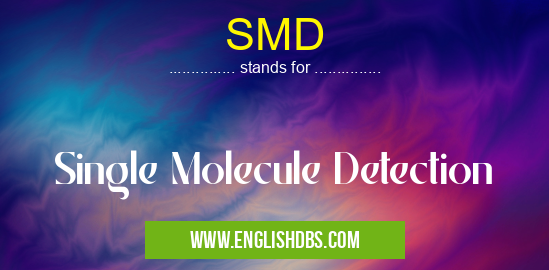What does SMD mean in UNCLASSIFIED
SMD (Single Molecule Detection) is a groundbreaking technique that allows scientists to investigate and analyze individual molecules, providing unprecedented insights into their properties and behaviors. This advanced technology has revolutionized various fields of science, including biology, chemistry, and physics.

SMD meaning in Unclassified in Miscellaneous
SMD mostly used in an acronym Unclassified in Category Miscellaneous that means Single Molecule Detection
Shorthand: SMD,
Full Form: Single Molecule Detection
For more information of "Single Molecule Detection", see the section below.
What does SMD Stand for?
SMD stands for Single Molecule Detection. It refers to the ability to detect and study individual molecules, enabling researchers to gain a deeper understanding of their dynamics, interactions, and characteristics.
How does SMD work?
SMD employs highly sensitive detection methods to capture signals emitted by individual molecules. These signals can be fluorescence, electrical, or magnetic in nature. By analyzing these signals, scientists can determine the presence, concentration, and behavior of specific molecules within a sample.
Applications of SMD
SMD has numerous applications across various scientific disciplines:
-
Biology:
- Studying protein folding and interactions
- Detecting and analyzing nucleic acids
- Investigating cellular processes at the molecular level
-
Chemistry:
- Analyzing reaction kinetics and mechanisms
- Monitoring chemical reactions in real-time
- Characterizing the properties of new materials
-
Physics:
- Investigating quantum effects at the nanoscale
- Studying the properties of materials and surfaces
- Exploring the behavior of individual atoms and molecules
Benefits of SMD
- High sensitivity: SMD enables the detection of individual molecules, providing unprecedented sensitivity for molecular analysis.
- Real-time monitoring: It allows scientists to observe and track molecular processes as they occur, capturing dynamic events that were previously impossible to study.
- Molecular specificity: SMD offers the ability to specifically target and detect individual molecules of interest, even within complex mixtures.
- Versatility: SMD can be applied to a wide range of sample types, including cells, tissues, and materials.
Essential Questions and Answers on Single Molecule Detection in "MISCELLANEOUS»UNFILED"
What is Single Molecule Detection (SMD)?
Single Molecule Detection (SMD) is a technique used to detect and analyze individual molecules within a sample. It allows researchers to study the behavior, structure, and dynamics of molecules at the single-molecule level, providing insights into cellular processes and molecular mechanisms.
What are the different methods of SMD?
There are various methods of SMD, including:
- Fluorescence-based methods: These techniques use fluorescent molecules to label and track individual molecules, enabling real-time observation and analysis.
- Microscopy-based methods: These methods utilize advanced microscopy techniques, such as super-resolution microscopy, to visualize and characterize individual molecules in their cellular context.
- Electrical-based methods: These techniques employ electrical sensors to detect and analyze the behavior of individual molecules, such as ion channels and membrane proteins.
What are the applications of SMD?
SMD has numerous applications in various fields, including:
- Biology: Studying molecular interactions, protein folding, enzyme kinetics, and cellular dynamics.
- Chemistry: Investigating chemical reactions, nanoparticle behavior, and drug interactions.
- Medicine: Diagnosing diseases, monitoring drug efficacy, and developing personalized therapies.
- Nanotechnology: Characterizing materials, studying nanoscale processes, and developing biosensors.
What are the limitations of SMD?
While SMD offers powerful insights, it also has limitations:
- Specificity: Ensuring that the detected signals are from the target molecules can be challenging.
- Sensitivity: Detecting low concentrations of molecules or rare events can be difficult.
- Cost and complexity: SMD techniques can require specialized equipment and expertise, making them relatively expensive and complex to implement.
What are the advantages of SMD over traditional ensemble measurements?
SMD offers several advantages over traditional ensemble measurements, which analyze molecules in bulk:
- Single-molecule resolution: Provides detailed information about the behavior and dynamics of individual molecules, which can vary from the average ensemble behavior.
- Rare event detection: Allows the identification and characterization of rare events or subpopulations that may be missed in ensemble measurements.
- Heterogeneity analysis: Enables the detection and quantification of molecular heterogeneity, providing insights into cellular diversity and variability.
Final Words: SMD is a powerful and versatile technique that has transformed the field of molecular analysis. By enabling the detection and study of individual molecules, SMD has opened up new avenues for scientific research and has contributed significantly to our understanding of the molecular world. As technology continues to advance, SMD is expected to play an even greater role in shaping the future of scientific discovery.
SMD also stands for: |
|
| All stands for SMD |
